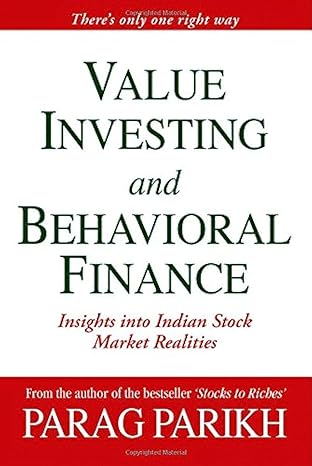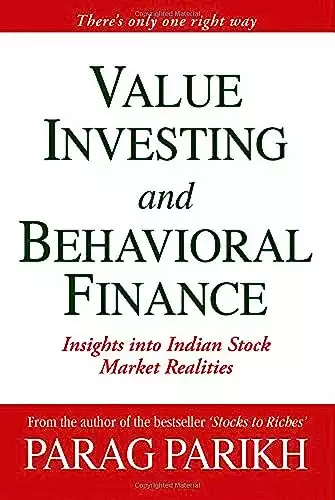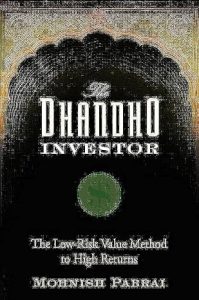Title and Author
- Book Title: Value Investing and Behavioral Finance
- Author: Parag Parikh
- Publication Date: January 2009
Introduction
"Value Investing and Behavioral Finance," written by Parag Parikh, offers a unique perspective on investing by combining the foundational principles of value investing with insights from behavioral finance. Published in January 2009, this book is designed to provide finance professionals with a deeper understanding of how psychological factors influence market behavior and investment decisions. For investors seeking to refine their strategies and gain a competitive edge, Parikh's work presents valuable perspectives on integrating cognitive and emotional insights with traditional investing methods. By addressing the biases and irrational behaviors that can affect investment outcomes, Parikh aims to equip readers with the knowledge to make more informed and disciplined investment decisions.
Content Summary
Parikh’s book systematically explores the core principles of value investing while interweaving concepts from behavioral finance to highlight how psychological biases and emotional factors can influence investment decisions and market movements.
Key Concepts:
- Value Investing: The strategy of selecting stocks that trade for less than their intrinsic values.
- Behavioral Finance: The study of how psychological influences and biases affect financial practitioners and markets.
Core Topics:
- Principles of Value Investing:
- Identifying Undervalued Stocks: Parikh emphasizes the importance of finding stocks that are priced below their intrinsic value, providing detailed methodologies for valuation.
- Fundamental Analysis: The book underscores the necessity of analyzing financial statements, company performance, and market conditions to assess the true value of an investment.
- Concept of Intrinsic Value: Understanding how to calculate and interpret intrinsic value is central to the value investing strategy.
- Psychological Biases in Investing:
- Overconfidence: Parikh discusses how overconfidence can lead investors to overestimate their knowledge and abilities, resulting in poor investment decisions.
- Herd Behavior: The tendency to follow the actions of a larger group can lead to market bubbles and crashes. Parikh explores how this behavior affects market trends.
- Loss Aversion: The book examines how the fear of losses can lead to irrational decision-making and risk aversion, impacting overall investment performance.
- Integration of Value Investing and Behavioral Finance:
- Market Inefficiencies: Parikh explains how cognitive biases can create market inefficiencies, presenting opportunities for value investors.
- Mitigating Biases: Strategies to recognize and mitigate the impact of psychological biases are discussed, helping investors maintain discipline in their investment approach.
- Disciplined Investing: The importance of adhering to a disciplined investment strategy to counteract emotional and cognitive biases is emphasized.
- Case Studies and Practical Examples:
- Real-World Scenarios: Parikh provides numerous case studies that illustrate the practical application of value investing principles and behavioral finance insights.
- Market Bubbles and Crashes: The book analyzes historical market events through the lens of behavioral finance, offering lessons on the psychological factors at play.
- Market Psychology and Investment:
- Understanding Market Sentiment: Parikh delves into the role of market sentiment in driving asset prices, highlighting how investor psychology can lead to price fluctuations.
- Impact on Asset Prices: The book explains how psychological factors and collective behaviors impact the pricing of assets, providing insights for more effective investment strategies.
By combining theoretical concepts with practical applications, Parikh’s "Value Investing and Behavioral Finance" offers finance professionals a comprehensive guide to improving their investment decisions by understanding and leveraging psychological factors in the market.
Critical Analysis
Strengths:
- Unique Integration of Disciplines:
- Parikh’s ability to blend the fundamentals of value investing with the insights from behavioral finance sets this book apart from others in the field. This interdisciplinary approach provides readers with a more holistic view of the investment process, emphasizing both the quantitative and qualitative aspects of investing.
- Practical Applications:
- The book excels in translating complex theories into practical strategies. Parikh includes numerous case studies and real-world examples that make the abstract concepts more tangible and applicable. This practical focus helps readers understand how to apply the principles of value investing and behavioral finance in their own investment practices.
- Insightful Analysis of Psychological Biases:
- Parikh delves deeply into common psychological biases that affect investors, such as overconfidence, herd behavior, and loss aversion. By highlighting these biases and offering strategies to mitigate their impact, the book provides valuable tools for investors looking to improve their decision-making processes and avoid common pitfalls.
- Emphasis on Disciplined Investing:
- The book strongly advocates for a disciplined approach to investing, which is crucial for overcoming the emotional and cognitive biases that can lead to suboptimal investment decisions. Parikh’s emphasis on maintaining discipline and adhering to a well-defined investment strategy is a key takeaway for readers.
Weaknesses:
- Complexity for Beginners:
- While the book offers valuable insights, some of its content may be challenging for beginners. The integration of value investing principles with behavioral finance concepts requires a certain level of prior knowledge in both areas. Readers new to investing or unfamiliar with behavioral finance might find some sections difficult to grasp.
- Repetition of Concepts:
- At times, the book tends to repeat certain concepts, which can make some sections feel redundant. While repetition can reinforce learning, it might also slow down the pace of reading and reduce the overall impact of the message.
Comparative Analysis:
- "The Intelligent Investor" by Benjamin Graham:
- Graham’s seminal work focuses solely on value investing, providing a thorough foundation in fundamental analysis and investment strategies. In comparison, Parikh’s book enhances this foundation by incorporating behavioral finance, offering a more contemporary perspective on how psychological factors influence investing.
- "Thinking, Fast and Slow" by Daniel Kahneman:
- Kahneman’s book delves into the broader field of cognitive psychology, exploring how our minds work and how biases affect our decisions. Parikh’s work narrows this focus to the realm of investing, providing specific strategies and insights tailored to finance professionals.
Overall Contribution:
Parikh’s "Value Investing and Behavioral Finance" stands out for its ability to merge two important fields of study—value investing and behavioral finance—into a cohesive and practical guide. By addressing both the analytical and psychological aspects of investing, the book provides readers with a comprehensive framework for making informed and disciplined investment decisions. While it may be complex for beginners, its insights and practical applications make it a valuable resource for finance professionals seeking to enhance their investment strategies.
Notable Quotes
Here are some notable quotes from "Value Investing and Behavioral Finance" by Parag Parikh:
- "In investing, what is comfortable is rarely profitable."
- This quote emphasizes the importance of stepping out of one's comfort zone to achieve significant investment returns.
- "The stock market is filled with individuals who know the price of everything, but the value of nothing."
- This highlights the difference between price and value, a central theme in value investing.
- "Risk comes from not knowing what you're doing."
- This quote underscores the importance of understanding one's investments to mitigate risk.
- "Investors are their own worst enemies. They keep changing their decisions based on short-term market movements."
- Parag Parikh stresses the behavioral aspect of finance and how emotional reactions can negatively impact investment decisions.
- "Patience is bitter, but its fruit is sweet."
- This proverb used in the book relates to the importance of patience in value investing.
- "The biggest challenge in investing is controlling your emotions."
- Emphasizing the role of psychological factors in making sound investment decisions.
- "Focus on value, not on prices. There is a big difference between the two."
- Reinforcing the key principle of value investing, which is to focus on the intrinsic value rather than the market price.
- "In the short run, the market is a voting machine. In the long run, it is a weighing machine."
- This quote by Benjamin Graham, included in Parag Parikh's book, reflects on how short-term market movements are driven by popularity and sentiment, while long-term movements reflect true value.
These quotes capture the essence of Parag Parikh's approach to value investing and behavioral finance, emphasizing the importance of patience, understanding, and emotional control in the investment process.
Conclusion
Summary: "Value Investing and Behavioral Finance" by Parag Parikh provides a comprehensive and insightful exploration of how psychological factors influence market behavior and investment decisions. By integrating the principles of value investing with the insights of behavioral finance, Parikh offers a unique perspective that enhances traditional investment strategies. The book covers key concepts such as the identification of undervalued stocks, the impact of cognitive biases like overconfidence and herd behavior, and the importance of disciplined investing. It also includes practical examples and case studies that illustrate the real-world application of these principles.
Recommendation: This book is highly recommended for finance professionals, particularly those interested in deepening their understanding of the psychological aspects of investing. Parikh’s thorough analysis and practical approach make it an invaluable resource for both novice and experienced investors. The combination of value investing and behavioral finance provides a well-rounded framework for improving investment decisions and achieving long-term success.
Final Thoughts: "Value Investing and Behavioral Finance" stands out as a significant contribution to the field of finance. Parikh’s ability to bridge the gap between financial theory and psychological insights makes this book a must-read for anyone looking to navigate the complexities of the investment world. While some content may be challenging for beginners and certain sections might feel repetitive, the overall value of the book’s insights and practical applications far outweigh these minor drawbacks. For finance professionals aiming to refine their investment strategies and better understand market dynamics, Parikh’s work offers essential guidance and knowledge.
Narrative Approach and Analysis
In "Value Investing and Behavioral Finance," Parag Parikh employs a unique narrative approach that intertwines theoretical concepts with practical insights, making complex financial theories accessible and engaging. His writing style effectively combines academic rigor with real-world applications, a method that not only informs but also captivates the reader. Here's how Parikh's narrative techniques enhance the book's impact:
Narrative Techniques Used by Parikh:
- Case Studies and Real-Life Examples:
- Parikh extensively uses case studies to illustrate the principles of behavioral finance and value investing. These examples are drawn from a wide range of markets and historical periods, providing a robust foundation for his arguments. By detailing specific instances where behavioral biases affected investment decisions and market outcomes, he offers concrete evidence of theoretical concepts in action.
- Anecdotal Evidence:
- Alongside case studies, Parikh incorporates anecdotes from his own experiences and those of renowned investors. These stories personalize the lessons, making them more relatable and easier to grasp. They serve as practical demonstrations of how seasoned investors apply behavioral finance principles to gain an edge in the market.
- Comparative Analysis:
- Another narrative technique Parikh employs is comparative analysis. He frequently compares the behaviors of successful and unsuccessful investors, drawing distinctions that highlight the consequences of ignoring or embracing behavioral finance insights. This comparative approach not only underscores the validity of his arguments but also motivates readers to introspect their own investment behaviors.
- Historical Context:
- Parikh places a strong emphasis on historical context, tracing the evolution of investing theories and practices. This historical perspective helps readers understand how and why certain investing strategies emerged and their relevance in today's financial landscape. It also showcases the cyclic nature of markets and investor behaviors, reinforcing the need for a behavioral finance framework.
- Dialogues and Questioning:
- Frequently, Parikh poses questions directly to the reader, creating a dialogic tone that encourages active engagement with the content. This questioning not only prompts reflection but also aids in the retention of complex information by making the reader an active participant in the learning process.
- Simplification of Complex Concepts:
- Perhaps most crucially, Parikh simplifies complex financial and psychological concepts without compromising on depth or accuracy. He uses clear, straightforward language and supports abstract ideas with visual aids like charts and graphs. This approach ensures that even readers with little to no background in finance can understand and apply the principles discussed.
Through these narrative methods, Parikh not only communicates the intricacies of value investing and behavioral finance but also ensures that his teachings are memorable and impactful. His narrative approach not only aids in understanding but also empowers readers to critically evaluate and apply the concepts to their own investing practices. This blend of theoretical exposition with practical application is what sets "Value Investing and Behavioral Finance" apart as a seminal work in its field.
Significance and Practical Applications
"Value Investing and Behavioral Finance" by Parag Parikh holds a distinctive place in financial literature, primarily due to its profound practical implications for investors seeking to navigate complex market dynamics. This book not only provides a theoretical framework for understanding the psychological factors influencing the markets but also offers actionable insights that can be directly applied to real-world investing.
Significance of the Book:
- Bridging Theory and Practice:
- Parikh's work is significant for its ability to bridge the gap between academic theory and practical application. By grounding behavioral finance principles in the real-world context of value investing, the book offers a comprehensive toolkit for investors to enhance their decision-making skills.
- Empowering Investors:
- This book empowers investors by illuminating how biases and emotions influence financial decisions. Understanding these factors allows investors to develop strategies to mitigate their effects, leading to more disciplined and rational investment practices.
- Advancing Financial Literacy:
- Parikh contributes to advancing financial literacy by making complex subjects accessible. His explanations help demystify the stock market's workings and encourage a more thoughtful and analytical approach to investing.
Practical Applications of the Book:
- Identifying Undervalued Stocks:
- One of the key practical applications Parikh discusses is the methodology for identifying undervalued stocks. He provides readers with criteria and analytical tools to assess a stock's true value, taking into account both financial metrics and market sentiment influenced by investor behavior.
- Developing a Contrarian Mindset:
- The book advocates for a contrarian approach to investing, which involves going against prevailing market trends. Parikh outlines how adopting this mindset can lead to discovering investment opportunities that others might overlook due to herd behavior.
- Improving Risk Management:
- By understanding and anticipating behavioral biases, investors can improve their risk management strategies. Parikh discusses how biases like loss aversion and overconfidence can lead to poor risk assessment and how recognizing these can help in crafting better risk mitigation tactics.
- Enhancing Portfolio Performance:
- The insights from the book can significantly enhance portfolio performance. By applying the principles of behavioral finance, investors can avoid common pitfalls and make more informed decisions that contribute to long-term wealth creation.
- Strategic Decision Making:
- Parikh’s book serves as a guide for strategic decision-making under uncertainty. He teaches how to analyze market cycles and investor sentiment, providing strategies for when to buy, hold, or sell investments based on behavioral cues rather than just quantitative analysis.
- Personal Growth and Self-Awareness:
- Beyond financial advice, the book promotes personal growth and self-awareness. Investors are encouraged to reflect on their own investing behavior and to continuously learn from both successes and mistakes.
In essence, "Value Investing and Behavioral Finance" by Parag Parikh is not just an academic exploration of finance. It is a practical guide that equips investors with the knowledge and tools to tackle the psychological challenges of the investment world. This blend of insightful analysis and practical advice makes it an invaluable resource for anyone interested in enhancing their investment approach through the understanding of behavioral finance.
Critical Analysis
"Value Investing and Behavioral Finance" by Parag Parikh is a seminal work that offers deep insights into the psychology of investing and its practical implications. However, like all scholarly works, it has its strengths and areas where it might fall short or could be expanded upon. Here’s a detailed critical analysis of the book:
Strengths:
- Comprehensive Approach:
- One of the book’s major strengths lies in its comprehensive approach. Parikh effectively combines the theoretical aspects of behavioral finance with the practical techniques of value investing. This integration not only enriches the reader's understanding but also enhances their ability to apply these concepts in real-world scenarios.
- Accessibility of Content:
- Parikh excels in breaking down complex concepts into understandable language without sacrificing depth. This accessibility makes the book valuable not just for professionals and seasoned investors but also for novices. His use of real-life examples and case studies further aids in demystifying the often opaque financial markets.
- Relevance to Modern Investing:
- The principles discussed in the book are highly relevant, especially in today's volatile and emotionally driven market environments. Parikh's focus on behavioral biases and how they affect market dynamics provides crucial insights that are applicable in any market condition.
Weaknesses:
- Potential for More Global Perspectives:
- While the book provides excellent coverage of behavioral finance and value investing, it primarily focuses on the Indian market and examples from Western economies. Expanding the geographical focus to include more examples from emerging markets and other global contexts could enhance its universality and appeal.
- Updating of Data and Examples:
- Given the rapid evolution of financial markets, some of the data and examples might benefit from updates to reflect the latest market conditions and technological advancements in trading and analysis.
- Depth in Certain Areas:
- While the book covers a broad range of topics, there might be room for deeper exploration in certain areas, such as algorithmic trading and its impact on behavioral finance, or more advanced statistical methods used in modern value investing.
Areas for Further Exploration:
- Technological Impact on Behavioral Finance:
- An exploration of how technology, especially AI and machine learning, is changing the landscape of behavioral finance could be a valuable addition. This includes how biases are amplified or mitigated by algorithms and automated trading systems.
- Behavioral Finance in Different Asset Classes:
- Expanding the discussion to include behavioral finance principles applied to different asset classes like bonds, commodities, and real estate could provide a more rounded view and practical advice for a broader audience.
- Long-Term Impact of Behavioral Shifts:
- A deeper analysis of long-term trends in investor behavior, especially in response to global economic crises or shifts, would add a valuable dimension to the existing narrative.
Overall, "Value Investing and Behavioral Finance" by Parag Parikh stands as a critical work in the understanding of market psychology and investment strategies. Its strengths certainly outweigh its weaknesses, making it a must-read for anyone interested in the intersection of psychology and finance.
Conclusion
"Value Investing and Behavioral Finance" by Parag Parikh is an essential contribution to the field of finance, particularly in how it merges the seemingly disparate disciplines of value investing and behavioral psychology. The book offers a profound yet accessible exploration of how psychological factors influence financial markets and investor behavior, providing readers with the tools to make more informed and rational investment decisions.
Parikh's work stands out for its practical application of complex theories, making it not only a theoretical guide but also a practical manual for investors. By elucidating the nuances of investor psychology and demonstrating how these insights can be applied in real-world scenarios, Parikh empowers investors to navigate the markets more effectively. His approach helps mitigate the impacts of cognitive biases and emotional decision-making, fostering a more disciplined and strategic form of investing.
The significance of this book extends beyond individual investors. It serves as a valuable resource for financial advisors, portfolio managers, and anyone involved in the financial markets who seeks to understand the underlying forces that drive investor behavior and market dynamics. Parikh’s emphasis on the psychological aspects of investing complements traditional financial analysis, offering a more holistic approach to understanding and participating in the financial markets.
As markets continue to evolve and new technologies and methodologies emerge, the insights from "Value Investing and Behavioral Finance" remain relevant. The book encourages a mindset that is critical, reflective, and vigilant—qualities that are indispensable in the face of the market’s complexities and the human emotions that shape them.
In conclusion, "Value Investing and Behavioral Finance" by Parag Parikh is more than just a cornerstone of financial literature; it is a guide that equips its readers with the knowledge and mindset needed to achieve success in the investing world. For anyone looking to deepen their understanding of the stock market and improve their investment strategies, this book is an invaluable asset.






